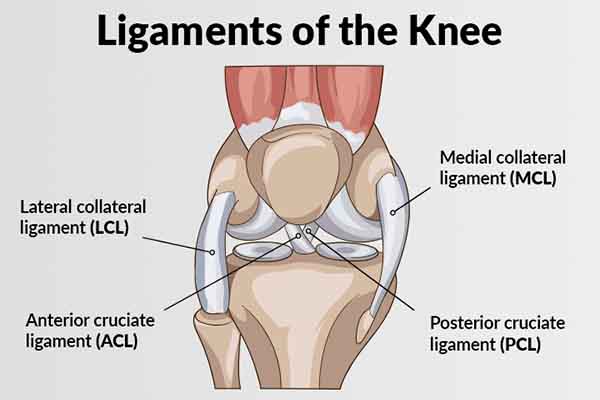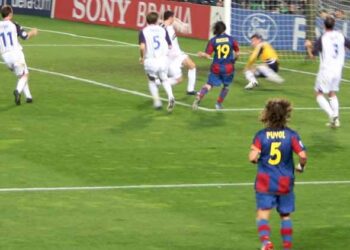
If you are ever into the contact sports like football, rugby, baseball, or basketball, it is important you know the signs that you may have sustained a knee ligament injury. Knee ligament injuries are relatively common. According to the American Society of Orthopedics, knee ligament injuries are among the most common sports injuries.
I have been opportune to learn about the ligaments of the knee joint and how they support and move the knee joint. There are also vulnerable positions where the ligaments and the joints are prone to injury.
Engaging in contact sports involving running, jumping, or sudden change of direction, as highlighted above, increases one’s chances of sustaining a knee injury. And if you are one who is frequently engaging in those sports, it will be of utmost importance to learn how to identify when you have sustained a knee injury and what to do afterward.
What are the Knee Ligaments
First of all, before we talk about what the knee ligaments are, let me start by talking about what ligaments are in the first place. Ligaments are strong, flexible bands of connective tissue that connect bones to other bones in the body. They are made of special protein material called collagen which gives them extreme strength and flexibility to perform their function of supporting bones in joints, and preventing excess movement across joints.
Ligaments are found in many parts of the body where two or more bones come in contact. The knee joint is not an exception. At the knee joint, the knee ligaments support the thigh bone at the knee joint over the bones of the leg. Injury to the knee ligaments would compromise these functions and cause significant pain and inflammation. Hence, early detection of a knee ligament injury is necessary to prevent more severe disability.
There are four knee ligaments at the knee joint: the anterior collateral ligament (ACL), the medial collateral ligament (MCL), the anterior cruciate ligament, and the posterior cruciate ligament (PCL). The image below will better describe the position of these ligaments across the knee joint.

How to Identify Knee Ligament Injury
Injuries to any of the ligaments above will have similar complications – pain, swelling, redness, bleeding into the joint, or to the outside, and loss of movement around the joint. It is pertinent to identify when you have had a knee ligament injury.
The features of knee ligament injury also resemble injury to other structures around the joint, like dislocation, fracture of a bone, or injury to a blood vessel. These carry different consequences and need to be managed differently. However, knee ligaments are more prone to injury than the other structures, such that before the other structures get injured, there must have been an injury to the knee ligaments as well.
Generally, knee ligament injuries can be classified into tear injuries, strain, and sprain, just like you could also have for muscles. More specifically, there are some signs that point to an injury to specific types of knee ligaments. Let’s see them below.
Anterior Cruciate Ligament (ACL) Injury
Anterior cruciate ligaments (ACL) are cross-shaped (cruciate) ligaments on the front (anterior) side of the knee joint. As you can see in the knee ligament image above, the anterior cruciate ligaments crisscrossed on each other to support the knee joint at the front. It joins the femur bone above to the tibia bone below towards the shin where it subsides the function of supporting the joint and aiding the normal movement of one bone over the other, as well as preventing excessive sliding of the tibia over the femur.
Due to its role in connecting extremely strong bones at the knee joint, the anterior cruciate ligament is the most commonly injured knee ligament, accounting alone for more than 40% of all knee ligament injuries.
Common signs that you have sustained an anterior cruciate ligament injury include the following:
- A pop sound: Hearing a loud “pop” sound at your knee joint during a rigorous sport is a good sign that there has been an anterior cruciate ligament.
- Pain: Almost immediately after the pop sound is heard, moderate to severe pain results.
- Unstable knee: Since the ACL contributes a great deal to the support of the knee joint, an unstable “wobbly” knee joint may result following an injury, especially a tear of the ACL.
Of all the signs of anterior cruciate ligament injury described here, the loud pop sound is the most characteristic of a knee ligament injury, especially the anterior cruciate ligament tear.
Medial Collateral Ligament (MCL) Injury
The medial collateral ligament (MCL) is a broad, thick band of tissue (ligament) on the knee joint at the inner aspect (medial aspect) of the knee joint as depicted in the diagram above. It connects the base of the thigh bone (femur) to the top of the leg bone (tibia). Its main function is to prevent the leg from protruding too far inward, offering stability and also allowing slight rotation.
Injuries to the MCL are quite common, though not as common as ACL injuries. They occur when the ligament stretches too far inwards due beyond its elastic limit due to external forces from the side of the knee joint. This results in a partial or complete tear of the ligament.
Common signs that you have sustained a MCL injury include the following:
- A popping sign is also a common finding in MCL injuries.
- Sudden pain.
- Knee stiffness: It becomes difficult to move, straighten or bend.
Posterior Cruciate Ligament (PCL) Injury
The PCL is the strongest ligament of the knee and therefore the least likely to be injured. There are two cruciate ligaments that cross each other (cruciate) on the back side or posterior aspect of the knee. They connect the base of the thighbone (femur) to the top of the fibula (small leg bone) and are responsible for controlling the backward motion of the knee (flexion) seen when you bend your knee so your heel can angle towards your back.
Injury to the PCL results when you over-extend the knee, that is when your thigh moves too forward over your lower leg as though you are falling over to the front when your leg is fixed on the ground. This results in a tear to the posterior cruciate ligaments.
Pain at the joint, swelling, and inability to move the joint, are also common features that may point to an injury to the PCL. Urgent medical attention should be sought if they are noticed.
Lateral Collateral Ligament (LCL) Injury
The LCL is found on the outer aspect of the knee joint connecting the femur above to the fibula below. It orients like the medial collateral ligament except that it lies on the outer side of the joint as shown in the diagram above. Because of its position and function, injuries to the LCL are not as common except due to a traumatic impact from the side.
The LCL stabilizes the joint against the side-way bending of the knee joint. Injuries to the LCL typically result from a direct blow to the inner part of the knee which can cause the ligament to stretch or tear. Because direct inner forces are rare, LCL injuries also become rare but when they occur, they may do so in conjunction with other knee ligaments injuries such as ACL or PCL injuries.
Signs of a LCL injury include pain on the outer part of the knee joint, a popping sound, swelling, limitation of movements around the joint, and a tearing sensation at the joint.
What to do after sustaining a Knee Ligament Injury
Following a knee ligament injury, first aid should be given to relieve pain, reduce inflammation, and further injury to surrounding structures. First aid intervention includes the RICE protocol (rest, ice, compression, and elevation). Further management of the injury depends on its level of severity. Based on this, three grades of knee ligament injury have been identified:
- Grade I (mild)
- Grade II (moderate)
- Grade III (severe)
Grade I or mild injury
Mild or grade I injury involves a sprain or strain of the ligament without any tear to its fibers. Treatment for mild injury typically includes the basic RICE first aid (knee rest, ice or cold pack, compression to prevent bleeding, and elevation), use of oral or parenteral analgesics or anti-inflammatory drugs such as paracetamol or ibuprofen, and use of knee brace to offer support and stability while the injury heals. Also, avoid activity involving movement of the joint for at least 6 weeks.
Grade II or moderate knee injury
This involves a partial tear in one or more of the knee ligaments. Treatment for moderate knee ligament injury is essentially the same as for mild injury – that is, rest, ice pack application, compression, elevation, analgesics and anti-inflammatory, brace application, and avoidance of activity.
In addition to the above, mild or moderate knee ligament injury may require the service of a health physiotherapist to facilitate the healing process and help restore the normal functions of the ligaments to the pre-injury state as much as possible.
Grade III or severe knee ligament injury
Severe or grade III knee ligament injury involves a complete tear of the knee ligament(s) or multiple ligament tears. Treatment of this type of knee ligament injury requires a more specialized approach involving the orthopedic surgeon as well as the basic interventions discussed earlier.
Basic first-aid treatment is administered and analgesics are given. After the wounded patient is stable, a recommended orthopedic surgeon will discuss the need for reconstructive knee surgery where the ligament(s) is/are repaired or reconstructed. Complete recovery after this surgery may take up to six months or more and you can achieve the same or nearly the same level of functionality as before the injury.
A custom knee brace can also serve as an alternative to knee surgery, to immobilize the joint and enhance its stability while it heals.
Most ACL injuries are serious and require surgery to fix. However, some mild ACL injuries may only require rest and rehabilitation exercises designed to help recover strength and stability.
Conclusion
Knee ligament injuries are common during sports involving running, jumping, and student change of direction, such as football, basketball, tennis, rugby, etc. Athletes and sportsmen involved in these sports should know what knee injuries are and how to recognize them so that they can know what to do when they or their teammates experienced a knee injury.
Common signs of a knee ligament injury include pain, swelling, wobbliness or stiffness, and a popping sound. Once identified, treatment of knee ligament injury depends on the grade of the injury. With adequate management, there can be full recovery and/or restoration of the functions of the injured joint.

















